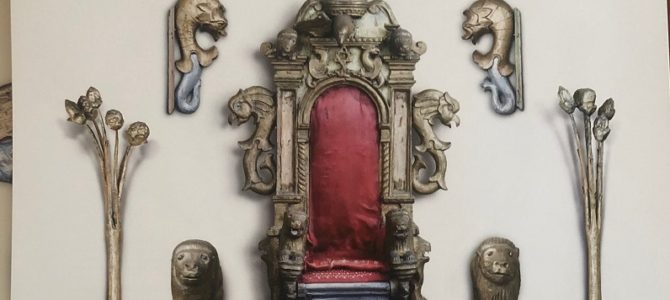The Lithuanian Jewish Community is greeting the new year, 5781, with the publication and distribution of our Jewish calendar for the coming year. As well as being attractive and nice to look at, this year’s calendar, as in past years, points back to our shared Litvak legacy. Every featured item once belonged to the Lithuanian Jewish communities and Lithuanian synagogues.
Dr. Aistė Niunkaitė has written a text about Jewish symbols and shared it with us in Lithuanian and in English translation below.
§ § §
See, the Lord has called by name Bezalel…
“Then Moses said to the people of Israel, ‘See, the Lord has called by name Bezalel the son of Uri, son of Hur, of the tribe of Judah and he has filled him with the Spirit of God, with skill, with intelligence, with knowledge, and with all craftsmanship to devise artistic designs, to work in gold and silver and bronze, in cutting stones for setting, and in carving wood, for work in every skilled craft'” (from Shemot 35:30–33). Then the Tanakh (the Bible) describes the ritual objects that Bezalel had to make by commandment of God: a portable sanctuary in the desert (mishkan), which became the prototype of the Temple in Jerusalem, with all the appurtenances, including the Ark of the Covenant and the seven-lamp menorah–the oldest fundamental symbols of Judaism, representing the idea of covenant between the Jewish nation and the God, and the experience of the Temple.
Thus the biblical account of the first artist Bezalel who was chosen by God Himself and endowed with the divine spirit of art, skills and knowledge of craft has laid the foundations for the traditional Jewish conception of art and aesthetics, and also for the development of the principal art forms and symbolic constructs. The traditional worldview rooted in the Tanakh and Talmud and the lifestyle defined by religion have, for many centuries, linked Jewish art not so much with the embellishment of daily objects but with rituals celebrating God, and with life- and year-cycle festivals both in the synagogue and at home. Because of this, every object of traditional Jewish art has a certain symbolic meaning and belongs to a specific rite.
Authoritative figures in Jewish religion encouraged creation of aesthetic ritual objects based on the Hiddur Mitzvah principle, which means exaltation and embellishment of religious commandments and precepts (Hebrew mitzvot), by enriching religious acts with aesthetic aspect. Such a demand for splendour of ceremonial space and ritual objects in Talmud is based on the line from Tanakh: This is my God and I will glorify him (from Shemot 15:2). It is then explained: “this means that one must make for His glory a beautiful sukkah, a beautiful lulav, a beautiful shofar, beautiful jewellery and a beautiful Torah scroll and it must be written by a skilled scribe with fine ink and fine pen and wrapped in beautiful silks” (Babylonian Talmud, Shabbat 133b). Such a concept of beauty is an expression of traditional attitude, where creation of something means creation for the God.
So it’s no surprise that the conservative Jewish culture of Lithuania, based on authority of tradition, cherished only traditional forms of art up till the second half of the 19th century, and creation of synagogue interiors and ritual objects was seen as holy work intended to the venerate the Lord. Artisans, carpenters and joiners, stonemasons, and self-taught folk artists, producing ritual objects, adorning synagogue interiors and carving aron kodeshes and bimahs, were respectfully considered masters of holy work. Their artistic expression was defined by tradition and study of religious texts, seen as one of the most important duties of a believer. This unique feature of Jewish culture has also provided the main sources of symbols for traditional Jewish art, namely the Tanakh, Talmud, collections of sages’ commentaries and midrashim and the Aggadah they contain–stories, legends and parables rich with the most colorful images and symbols, encountered by everyone who reads the traditional texts, from as early as childhood. In the works of the Jewish masters who grew up surrounded by books, the textual concepts familiar from their early years acquire the shape of colorful symbolic images in the decoration of synagogue interiors and ritual objects.
Among the symbols of traditional Jewish art with their many notional connotations, images from biblical Judaism and the tradition of commentaries prevail, which give foundation to communal life by illustrating two main directions: towards the past through the experience of the Covenant, and to the future through the vision of the prophesied messianic world. The experience of the Jewish Covenant with God, the Temple and the Promised Land together with messianic ideas have defined the uniqueness of both the key ritual objects and of the symbols used in the images decorating them.
Dr. Aistė Niunkaitė Račiūnienė


